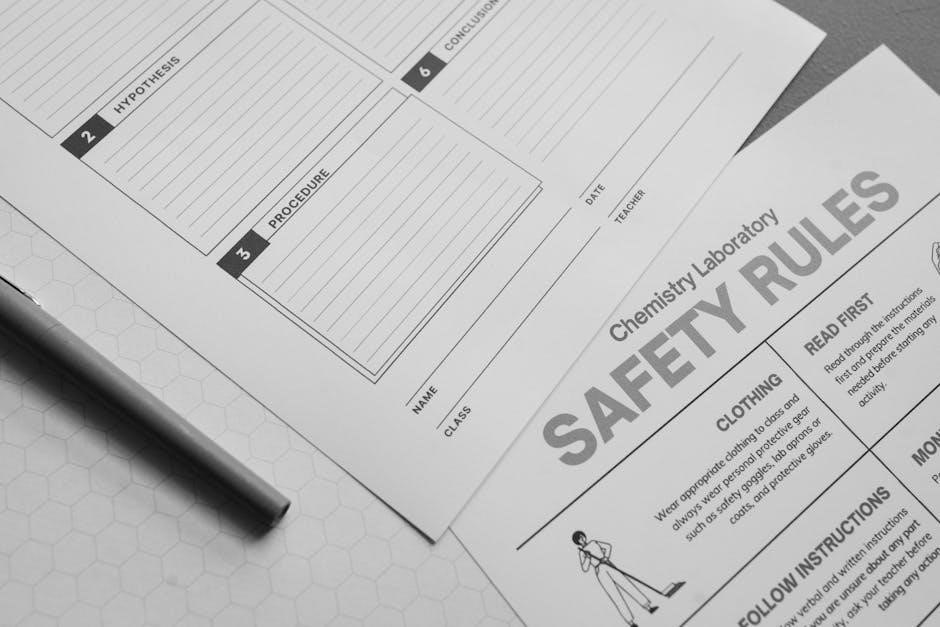The 6.7 Cummins EGR delete enhances engine performance by eliminating exhaust gas recirculation, improving efficiency and reducing emissions-related issues. It’s a popular modification for diesel enthusiasts, offering increased power and torque while simplifying engine operations.
Overview of EGR Delete and Its Purpose
An EGR delete is a modification that removes the Exhaust Gas Recirculation system from a 6.7 Cummins engine, aiming to improve performance and efficiency. By eliminating exhaust gases from the combustion chamber, it reduces soot buildup and lowers engine temperatures. This modification is popular among diesel enthusiasts seeking enhanced power, torque, and fuel economy. The process involves removing EGR-related components and tuning the engine to optimize its operation without the EGR system, simplifying engine function and reducing maintenance needs.
Why Consider an EGR Delete for Your 6.7 Cummins Engine
Considering an EGR delete for your 6.7 Cummins engine can lead to improved performance, reduced maintenance, and enhanced efficiency. By eliminating the EGR system, you minimize the risk of soot-related damage and lower engine temperatures. Additionally, it can increase horsepower and torque, making it a beneficial modification for diesel enthusiasts seeking better engine performance and reliability. This upgrade is particularly appealing for those who want to simplify their engine’s operation and reduce long-term maintenance costs associated with the EGR system.

What is an EGR Delete?
An EGR delete is a modification that removes or disables the Exhaust Gas Recirculation system, reducing soot buildup and potential engine damage for improved performance.
Definition and Function of the EGR System
The Exhaust Gas Recirculation (EGR) system reduces nitrogen oxide emissions by recirculating a portion of exhaust gases into the engine’s combustion chamber. This process lowers combustion temperatures, decreasing NOx production. The EGR valve regulates gas flow, while the EGR cooler minimizes temperature before re-entry. Sensors monitor system performance, ensuring emissions compliance and engine efficiency. However, issues like soot buildup and reduced performance have led some to consider EGR deletion for improved engine operation.
How EGR Delete Works and Its Impact on Engine Performance
An EGR delete removes the Exhaust Gas Recirculation system, preventing exhaust gases from re-entering the engine. This eliminates soot buildup and reduces engine contamination. Deleting the EGR system typically involves unplugging sensors, removing the EGR valve and cooler, and installing a delete kit. This modification can increase horsepower and torque by allowing the engine to breathe more efficiently. However, it may lead to DPF (diesel particulate filter) issues and requires proper tuning to avoid engine light activation and performance problems.

Benefits of Performing an EGR Delete
An EGR delete boosts engine performance by increasing horsepower and torque, improving fuel efficiency, and reducing maintenance costs associated with EGR-related components and soot buildup.
Increased Horsepower and Torque
Deleting the EGR system on a 6.7 Cummins engine significantly enhances horsepower and torque. By eliminating the recirculation of exhaust gases, the engine operates with cleaner combustion, reducing soot buildup. This results in improved power output, especially under load. The engine breathes better, allowing for more efficient combustion and increased performance. Drivers often notice a smoother and more responsive driving experience, making it ideal for towing and hauling heavy loads. The gains are particularly noticeable in real-world driving conditions.
Improved Fuel Efficiency
Eliminating the EGR system on a 6.7 Cummins engine can lead to improved fuel efficiency. By preventing exhaust gases from re-entering the combustion chamber, the engine operates with cleaner combustion, reducing soot buildup and allowing for better fuel utilization. This results in enhanced mileage, especially during highway driving or when towing. Additionally, tuning adjustments post-delete further optimize fuel injection, contributing to overall efficiency gains. Many drivers report noticeable improvements in fuel economy after performing the EGR delete, making it a beneficial modification for both performance and economy.
Reduced Maintenance Costs
Performing an EGR delete on your 6.7 Cummins engine can significantly reduce maintenance costs. Eliminating the EGR system minimizes soot buildup and corrosion in critical components like the intake manifold and valves. This reduction in contamination leads to fewer issues with the DPF (diesel particulate filter) and EGR cooler, which are costly to repair or replace. Additionally, removing the EGR system simplifies engine operation, lowering the likelihood of premature wear on related parts. This results in long-term savings and fewer trips to the mechanic.

Necessary Tools and Materials for the EGR Delete
Essential tools include wrenches, screwdrivers, and pliers. Materials needed are an EGR delete kit, coolant drain pan, tuner, and gaskets. Ensure all components are compatible with your 6.7 Cummins engine.
Essential Tools Required for the Installation
The installation of an EGR delete kit requires specific tools, including wrenches, screwdrivers, and pliers. A drain pan is necessary for coolant drainage. Additional tools may include a Torx driver for EGR valve removal and a socket set for bolt removal. Ensure all tools are compatible with your engine’s specifications. A tuner is also essential for recalibrating the engine computer post-installation. Always refer to the manufacturer’s instructions for a precise list of tools and materials needed for a successful installation.
Recommended EGR Delete Kits and Components
High-quality EGR delete kits are essential for a successful installation. These kits typically include an EGR valve blocker, coolant line plugs, and a bypass pipe. Premium kits often feature durable materials like stainless steel for longevity. Tuning software is also recommended to recalibrate your engine computer post-installation. Always choose a reputable brand to ensure compatibility and performance. Additionally, consider consulting with a diesel specialist or referring to detailed installation guides for optimal results and to avoid potential issues.
Step-by-Step Instructions for 6.7 Cummins EGR Delete
Drain coolant if necessary, disconnect EGR sensors, and remove the EGR valve and cooler. Install the delete kit, reconnect components, and tune the engine for optimal performance.
Unplugging EGR Sensors and Disconnecting Electrical Connectors
Start by locating and unplugging the EGR sensors to prevent interference during the deletion process. Gently pull the connectors straight off the sensors to avoid damage. Next, disconnect the electrical connectors linked to the EGR system, ensuring no residual power supply remains. Use a wiring diagram if needed to identify all relevant connections. This step is crucial for safely removing the EGR components and preparing the engine for the delete kit installation. Proper disconnection prevents electrical issues and ensures a smooth transition to the modified system.
Removing the EGR Valve and Cooler
Locate the EGR valve and cooler, typically connected to the exhaust system and intake manifold. Use a wrench or socket set to remove the bolts securing them. Drain coolant if necessary to prevent spills. Carefully pull the EGR valve and cooler out of their mounts, avoiding damage to surrounding components. Ensure coolant lines and hoses are managed properly. Proceed with caution, consulting a repair manual or tutorial if needed, to safely remove these components without causing engine issues.
Installing the EGR Delete Kit and Reconnecting Components
Mount the EGR delete kit in place of the removed valve and cooler, ensuring a secure fit. Reconnect the electrical connectors to the engine control system. Attach the intake manifold and exhaust system components as specified. Refill coolant if drained and bleed the system to remove air pockets. Double-check all connections for leaks. Finally, tune the engine with an aftermarket tuner to optimize performance and ensure proper functionality without the EGR system.

Important Considerations Before and After the EGR Delete
Drain coolant if needed, handle coolant lines carefully, and ensure proper reconnection. Check local emissions laws for compliance. Monitor for potential issues like DPF clogging post-delete.
Draining Coolant and Handling Coolant Lines
Draining coolant is essential if the EGR cooler is connected to the engine’s cooling system. Locate the coolant drain valve, typically near the radiator, and collect the fluid in a pan. Properly disconnect the coolant lines from the EGR cooler to avoid spills and damage.
After draining, carefully remove the lines and ensure they are sealed to prevent leaks. Reinstall new gaskets or seals if necessary. Always refer to your vehicle’s manual for specific guidance. Handling coolant lines safely prevents engine damage and ensures a smooth EGR delete process.
Potential Issues and Troubleshooting Tips
Common issues after an EGR delete include DPF clogging, reduced fuel efficiency, or error codes. Ensure the EGR delete kit is installed correctly to avoid these problems. If issues arise, check for leaks in the exhaust or coolant systems and verify proper sensor connections. Using a tuner to reset the ECU can often resolve error codes. If problems persist, consult a professional to diagnose and repair any underlying issues. Proper installation and maintenance are key to avoiding long-term damage.

Legal and Emissions Compliance
Performing an EGR delete may violate emissions regulations. It is essential to check local laws, as it is often restricted to off-road use only. Legal consequences can result if non-compliant.
Understanding Emissions Regulations and Off-Road Use
Emissions regulations strictly govern EGR systems to reduce pollution. Tampering with or removing emissions components, like the EGR, is illegal for on-road vehicles under the Clean Air Act. Off-road use, however, offers exemptions, allowing EGR deletes for racing or non-highway applications. Ensure compliance by verifying local laws and using EGR delete kits specifically designed and labeled for off-road use only. Always consult regulations before modifying your vehicle to avoid legal repercussions and potential fines.
Consequences of Non-Compliance
Performing an EGR delete on a vehicle used for on-road purposes violates emissions regulations, leading to severe penalties. Fines can range from $5,000 to $10,000 or more for individuals, while businesses may face higher penalties. Non-compliance may also result in revoked registration, denied inspections, or even criminal charges. Additionally, tampering with emissions systems can void factory warranties and lead to insurance issues. Always ensure compliance with local laws to avoid legal and financial repercussions. Penalties vary by jurisdiction, so verify regulations before proceeding.

Maintenance and Upkeep Post-EGR Delete
Regular maintenance post-EGR delete includes monitoring coolant levels, inspecting engine components, and ensuring proper filter replacements to sustain performance and prevent potential issues. Schedule inspections regularly.
Regular Maintenance to Ensure Optimal Performance
Regular maintenance is crucial after an EGR delete to maintain optimal performance. Check coolant levels frequently, as the EGR cooler removal can affect the cooling system. Inspect hoses and connections for leaks to prevent engine damage. Monitor exhaust gas temperatures and ensure proper diesel particulate filter (DPF) function if equipped. Service air and fuel filters regularly to avoid restricted airflow and fuel flow. Additionally, consider using diesel fuel conditioners to maintain fuel quality and performance. Schedule routine tune-ups to address any emerging issues promptly.
Monitoring Engine Health and Addressing Potential Problems
Monitoring engine health post-EGR delete is essential to ensure long-term reliability. Regularly check coolant levels and temperatures, as EGR cooler removal can impact cooling efficiency. Use a scan tool to monitor engine performance and troubleshoot error codes promptly. Watch for excessive soot buildup or DPF clogging, which may require adjustments. Keep an eye on exhaust gas temperatures (EGT) to prevent overheating. Address any decrease in power or unusual sounds immediately to avoid costly repairs. Proper monitoring ensures your engine runs smoothly and maintains peak performance.